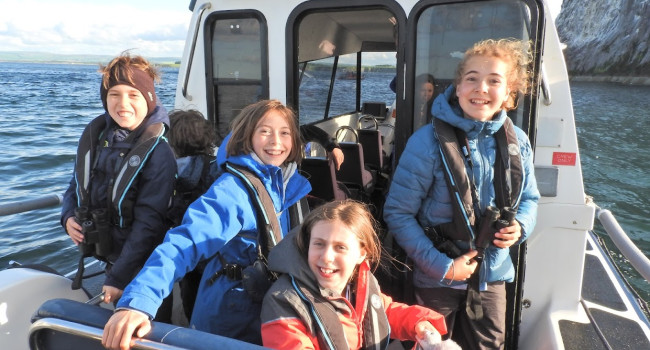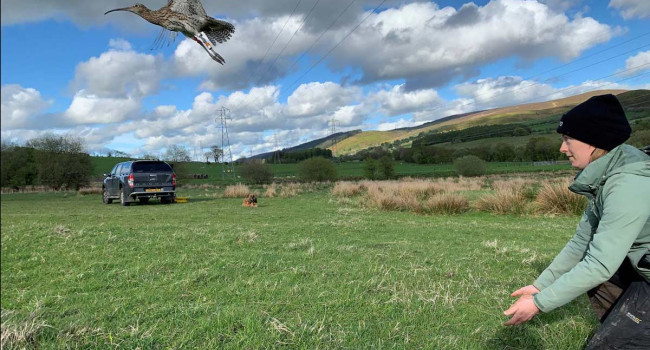Welsh Redstarts start up
01 Jul 2011 | No. 2011-30
Issued by BTO on behalf of BTO, JNCC and RSPB
Redstarts, characteristic birds of Welsh woodlands, enjoyed a successful year in 2010. Latest figures from the BTO/JNCC/RSPB Breeding Bird Survey (BBS), released today, reveal that numbers increased by 28% between 2009 and 2010. However, Skylarks, Meadow Pipits and Starlings are declining.
their highest levels in Wales since start of BBS
In 2010, numbers of the amber-listed Redstart reached their highest levels in Wales since the start of the BBS in 1994, perhaps due to above-average rainfall in their wintering area, the Sahel region south of the Sahara. Redstart is just one of 53 species monitored by the BBS in Wales, and the latest figures show that 2010 was a good summer for many other birds in Wales, with species as diverse as Blackcap (+22%), Rook (+59%) and the red-listed Tree Pipit (+83%) and Linnet (+38%) increasing in numbers between 2009 and 2010.
However, not all birds are doing well in Wales. Three birds of open countryside – Skylark, Meadow Pipit and Starling – have all fallen to their lowest levels in Wales since the start of the survey, showing declines of -20%, -16% and -63% respectively since 1994. These declines are particularly worrying, as all three species are red- or amber-listed birds of conservation concern.
Kate Risely, BBS organiser at the British Trust for Ornithology, commented, “We owe this knowledge of bird population trends to dedicated volunteer birdwatchers who take part in the Breeding Bird Survey in Wales. Their records help us to build a detailed picture of how our bird populations are responding to environmental pressures.”
Deborah Procter, Senior Monitoring Ecologist at Joint Nature Conservation Committee, added “The Breeding Bird Survey provides a rich source of data to help understand the conservation status of UK birds. UK population trends from the BBS enable us to investigate how species respond to multiple challenges, not only in the UK but further afield. This is illustrated in this year’s report by reference to the impacts of climate change on UK bird communities and to the perils that face migrants on their journey. Such knowledge helps government’s agencies and others target scarce resources to where conservation action is most needed.”
Dr Seán Christian, Head of Conservation for RSPB Cymru said: "This important survey gives us the vital information to focus our conservation efforts. It’s great to see increasing numbers of redstarts in Welsh woods in 2010, when so many other long-distance migrants are declining. But the Breeding Bird Survey also provides undeniable evidence confirming what many people who visit, live and work in the Welsh countryside have sensed for some time – that there has been a dramatic decline in many of our farmland birds, with once familiar birds like skylarks, meadow pipits and starlings rapidly disappearing as breeding species here in Wales."
Notes for Editors
- For a PDF of the full report visit www.bto.org/bbs/results/BBSreport10
- The Breeding Bird Survey is run by the British Trust for Ornithology (BTO) and is jointly funded by BTO, the Joint Nature Conservation Committee (JNCC) (on behalf of the statutory nature conservation agencies: Council for Nature Conservation and the Countryside, the Countryside Council for Wales, Natural England and Scottish Natural Heritage), and the Royal Society for the Protection of Birds (RSPB).
- The BTO/JNCC/RSPB Breeding Bird Survey (BBS) is a national project aimed at keeping track of changes in the breeding populations of widespread bird species in the UK. The BBS involves over 2,500 participants who now survey more than 3,200 sites across the UK, enabling us to monitor the population changes of over 100 bird species. Knowing to what extent bird populations are increasing or decreasing is fundamental to bird conservation.
- The information provided by the BBS provides a cornerstone for conservation action for birds in the UK. This survey forms an integral part of the Government’s Quality of Life indicators.
- This important survey is carried out by volunteer birdwatchers throughout the UK, who receive no financial reward or expenses for their efforts. We are indebted to them for their tremendous support.
- The BTO is the UK’s leading bird research organisation. Over thirty thousand birdwatchers contribute to the BTO’s surveys. They collect information that forms the basis of conservation action in the UK. The BTO maintains a staff of 100 at its offices in Norfolk, Stirling and Bangor, who analyse and publicise the results of project work. The BTO’s investigations are funded by government, industry and conservation organisations.
Contact information
Kate Risely
(Breeding Bird Survey Organiser)
Office: 01842 750050
Email: bbs [at] bto.org
Kelvin Jones
(BTO Wales Development Coordinator)
Mobile: 07979 713282
Email: kelvin.jones [at] bto.org
Paul Stancliffe
(BTO Press Officer)
Office: 01842 750050 (9am-5.30pm)
Mobile: 07585 440910 (anytime)
Email: press [at] bto.org
Daniel Jenkins-Jones
(RSPB Cymru Head of Public Affairs)
Office: 02920 353011
Images are available for use alongside this News Release.
Please contact images [at] bto.org quoting reference 2011-30
The BTO has an ISDN line available for radio interviews
Please contact us to book an interview Office: 01842 750050






Share this page